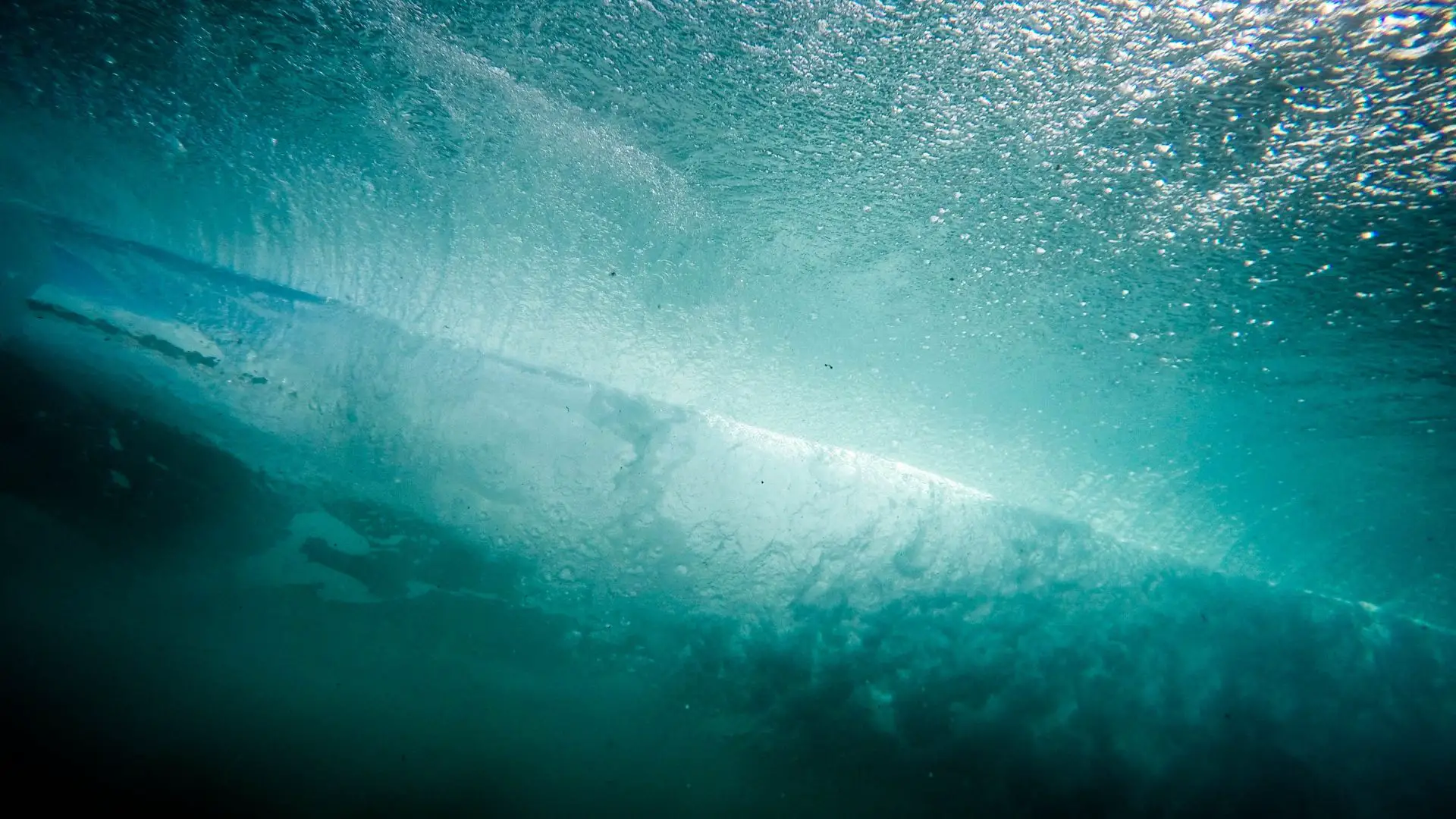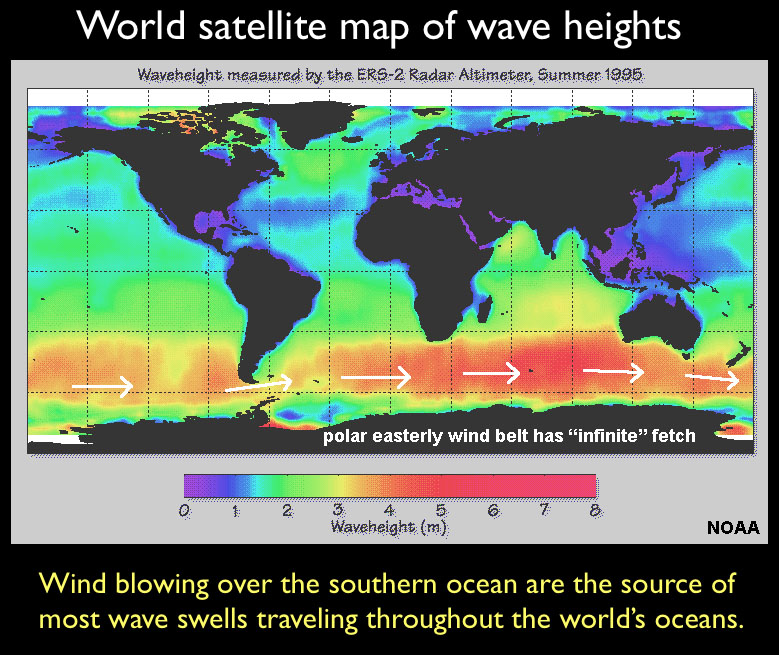What is Swell in The Ocean: Explained!

Swell in the ocean is what creates the very waves we surf!
But, what is swell? How is swell created and is swell the same as waves?
This article will cover what is swell in the ocean ensuring your knowledge on ocean swell will be second to none after reading this!
What Is Swell?
Swell comprises mechanical or surface gravity waves created by remote weather systems, travelling over thousands of miles across oceans and seas.
Ocean Swell Definition
Ocean swell is a series of long-period waves formed by persistent winds, travelling across vast distances.
More organised than wind-generated waves, swells last for days travelling across our world oceans and vary in size from a few feet to over 10 metres.
How Do I Measure Ocean Wave Energy?
Measuring ocean wave energy involves advanced methods such as wave buoys with sensors and satellites equipped with altimeters.
Wave buoys track vertical motion, aiding in calculating wave height and energy. Meanwhile, satellites provide a broader perspective from space, capturing valuable data.
The combination of these techniques, along with numerical models and coastal monitoring stations, ensures a comprehensive understanding of ocean wave energy for the development of sustainable solutions.
Walter Munk and the Weber Brothers
Wilhelm Eduard Weber and Ernst Heinrich Weber pioneered the experimental study of waves, discovering the correlation between water droplet rotation and surface wave movement.
They introduced the concept of a travelling wave train, commonly known as a swell.
In the 1940s, Walter Heinrich Munk, a renowned physical oceanographer, collaborated with Harald Sverdrup to establish wave forecasting.
What Causes Ocean Swells
Ocean swells are the result of intricate interactions between wind, water, and the Earth's rotation.
Strong winds, often originating from distant storms or weather systems, pass energy to the ocean surface. As these winds blow across vast stretches of open water, they generate waves.
The longer these winds persist and the greater the distance they cover, the more organised and consistent the resulting swells become.
Groundswells and Windswells
Groundswells are long-period waves that travel across oceans, originating from distant weather systems. Windswells are generated by local winds in the immediate vicinity, producing shorter and often choppier waves.
Groundswells
Groundswells refer to ocean waves that have travelled across vast distances, often originating from distant storm systems or weather events. These swells are characterised by longer wave periods and a more organised wave train.
As they move into shallower waters near coastlines, groundswells often result in powerful and consistent waves, making them highly sought after by surfers for their quality and rideability.
Windswells
In contrast, wind swells are generated by local winds that blow over the surface of the water.
These waves tend to have shorter wave periods and are often choppier compared to groundswells.
Windswells are more influenced by the immediate wind conditions, making them less predictable and sometimes less desirable for surfers seeking well-formed and powerful waves.
Tropical Storm Swells
Tropical storm swells are powerful waves generated by tropical storms and hurricanes in warm ocean regions.
As these storms intensify, they produce strong winds that travel across expansive areas of open water.
These winds, combined with the storm's energy, create large and long-period waves known as tropical storm swells.
The swells can travel over vast distances, affecting coastlines far from the storm's centre. Tropical storm swells pose significant risks, leading to dangerous surf conditions, coastal erosion, and potential flooding.
Height of Ocean Swells
The height of ocean swells refers to the vertical measurement from the trough (lowest point) to the crest (highest point) of a wave.
It is a critical parameter indicating the energy and force carried by the swells. Swell height is typically measured in metres or feet and plays a significant role in determining the impact of the waves on coastal areas, maritime activities, and surfing conditions.
Direction of Ocean Swells
The direction of ocean swells is the compass bearing from which the swells are approaching. It is commonly expressed in degrees, indicating the angle of the swell's approach relative to true north.
Understanding the direction of swells is crucial for various purposes, such as navigation, surf forecasting, and coastal management. Swell direction influences wave behaviour and how waves interact with coastal features, making it an essential aspect of assessing ocean conditions.
Propagation, Dispersion, and Grouping
Propagation
Propagation in the context of ocean waves refers to the transmission of wave energy through the water. As waves travel across the ocean, they carry energy from one point to another.
The speed and direction of wave propagation depend on factors such as wind strength, water depth, and the characteristics of the waves themselves.
Dispersion
Dispersion involves the separation of a wave into its individual components based on their wavelengths.
In ocean waves, dispersion can cause waves of different frequencies and periods to travel at different speeds.
Grouping
Grouping, or wave grouping, occurs when waves temporarily come together to form larger wave groups.
This phenomenon is a result of the varying speeds of waves within a wave train. As waves with similar periods travel, they may synchronise briefly, creating a larger and more noticeable wave crest.
Swell vs Wave vs Wind
Swell
A swell refers to a series of long-period ocean waves that have travelled over great distances, typically generated by distant weather systems or storms.
Wave
Waves are general disturbances on the water's surface caused by the transfer of energy from wind to the water.
Wind
Wind, in the context of oceanography, is the primary driver of wave generation. The friction between the air and the water's surface transfers energy, creating ripples that can evolve into waves.
Are Ocean Swells Dangerous
Ocean swells can pose various dangers, particularly for those venturing into the water. While swells themselves are a natural and mesmerising phenomenon, their power and size can create hazardous conditions including some of the biggest waves in the world.
For surfers, swimmers, and boaters, the force of large swells can lead to strong rip currents and challenging surf conditions, increasing the risk of accidents and drowning. A greater danger to be aware of is square waves.
Is 2m Swell Rough?
A 2-metre swell is considered moderate and generally not extremely rough, however if you're a beginner surfer it may be challenging. Swell height is a crucial factor in determining sea conditions, and a 2-metre swell would typically result in moderate waves.
Swell Ocean Synonym
- Tsunami
- Eagre
- Giant Wave
- Seiche
- Seismic Sea Wave
Does The Moon Cause Swell In The Ocean?
Yes, the moon plays a significant role in causing waves on Earth. Gravitational forces between the moon and the Earth, along with the Earth's rotation, lead to the phenomenon of tidal forces.
These tidal forces create the regular rise and fall of sea levels known as tides. While tides themselves are not waves, they influence wave formation.
Summing It Up: What To Do Now
Nice! Now you understand what ocean swell is and how the waves that you surf are created! Make sure to check where your wave buoys are located near your local surf spots to check your upcoming swell!
If your interested in learning more about surfing discover our many guides that will inform you on your surfing journey. Don't forget to follow us on Facebook & Instagram to stay informed on our amazing surf shots and stories shared from surf creators around the world!
Frequently Asked Questions
How long do ocean swells last?
Ocean swells can last for several days, and their duration depends on various factors such as the generating wind's persistence and strength.
Are swells bigger than waves?
Swells are a specific type of wave. Generally, when people refer to "waves," they might be talking about wind-generated waves, which can be smaller and choppier compared to the more organised and consistent swells.
Which ocean has the biggest swells?
The Pacific Ocean is known for producing some of the biggest and most powerful ocean swells. Regions like the North Pacific, particularly during winter, can experience massive swells due to strong and persistent winds.
Is an ocean swell a wave?
Yes, an ocean swell is a type of wave. It is a series of long-period waves that have travelled across the ocean from their area of origin.
How big do ocean swells get?
Ocean swells can vary widely in size. They typically range from a few feet to over 10 metres (30 feet) in height, depending on the strength and duration of the winds that generated them.
Are swells deep water waves?
Yes, swells are deep water waves. Unlike wind-generated waves, swells have moved out of the area where they were generated and can travel across vast expanses of open ocean without interference from the seafloor.



